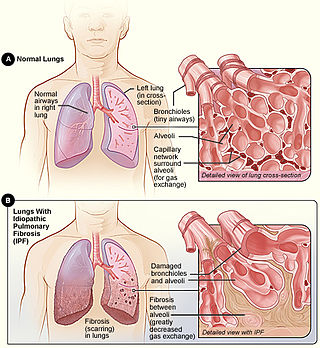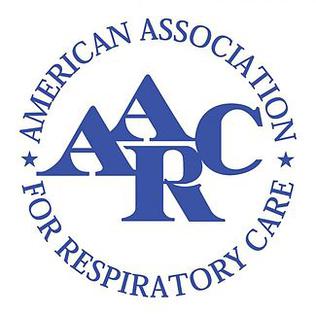
A respiratory therapist is a specialized healthcare practitioner trained in critical care and cardio-pulmonary medicine in order to work therapeutically with people who have acute critical conditions, cardiac and pulmonary disease. Respiratory therapists sometimes graduate from a college or university with a degree in respiratory therapy and have passed a national board certifying examination. The NBRC is responsible for credentialing as a CRT, or RRT,

Bronchiectasis is a disease in which there is permanent enlargement of parts of the airways of the lung. Symptoms typically include a chronic cough with mucus production. Other symptoms include shortness of breath, coughing up blood, and chest pain. Wheezing and nail clubbing may also occur. Those with the disease often get lung infections.
Crackles are the clicking, rattling, or crackling noises that may be made by one or both lungs of a human with a respiratory disease during inhalation, and occasionally during exhalation. They are usually heard only with a stethoscope. Pulmonary crackles are abnormal breath sounds that were formerly referred to as rales.

Pulmonology, pneumology or pneumonology is a medical specialty that deals with diseases involving the respiratory tract. It is also known as respirology, respiratory medicine, or chest medicine in some countries and areas.

Interstitial lung disease (ILD), or diffuse parenchymal lung disease (DPLD), is a group of respiratory diseases affecting the interstitium (the tissue and space around the alveoli of the lungs. It concerns alveolar epithelium, pulmonary capillary endothelium, basement membrane, and perivascular and perilymphatic tissues. It may occur when an injury to the lungs triggers an abnormal healing response. Ordinarily, the body generates just the right amount of tissue to repair damage, but in interstitial lung disease, the repair process is disrupted, and the tissue around the air sacs becomes scarred and thickened. This makes it more difficult for oxygen to pass into the bloodstream. The disease presents itself with the following symptoms: shortness of breath, nonproductive coughing, fatigue, and weight loss, which tend to develop slowly, over several months. The average rate of survival for someone with this disease is between three and five years. The term ILD is used to distinguish these diseases from obstructive airways diseases.

A pneumonectomy is a surgical procedure to remove a lung. It was first successfully performed in 1933 by Dr. Evarts Graham. This is not to be confused with a lobectomy or segmentectomy, which only removes one part of the lung.

Chest physiotherapy (CPT) are treatments generally performed by physical therapists and respiratory therapists, whereby breathing is improved by the indirect removal of mucus from the breathing passages of a patient. Other terms include respiratory or cardio-thoracic physiotherapy.

Carlos Alberto de Barros Franco, is a Brazilian physician and professor, specializing in Pneumology. He graduated in 1971.

Idiopathic pulmonary fibrosis (IPF), or (formerly) fibrosing alveolitis, is a rare, progressive illness of the respiratory system, characterized by the thickening and stiffening of lung tissue, associated with the formation of scar tissue. It is a type of chronic scarring lung disease characterized by a progressive and irreversible decline in lung function. The tissue in the lungs becomes thick and stiff, which affects the tissue that surrounds the air sacs in the lungs. Symptoms typically include gradual onset of shortness of breath and a dry cough. Other changes may include feeling tired, and abnormally large and dome shaped finger and toenails. Complications may include pulmonary hypertension, heart failure, pneumonia or pulmonary embolism.
The American Thoracic Society (ATS) is a nonprofit organization focused on improving care for pulmonary diseases, critical illnesses and sleep-related breathing disorders. It was established in 1905 as the
Restrictive lung diseases are a category of extrapulmonary, pleural, or parenchymal respiratory diseases that restrict lung expansion, resulting in a decreased lung volume, an increased work of breathing, and inadequate ventilation and/or oxygenation. Pulmonary function test demonstrates a decrease in the forced vital capacity.

Pulmonary function testing (PFT) is a complete evaluation of the respiratory system including patient history, physical examinations, and tests of pulmonary function. The primary purpose of pulmonary function testing is to identify the severity of pulmonary impairment. Pulmonary function testing has diagnostic and therapeutic roles and helps clinicians answer some general questions about patients with lung disease. PFTs are normally performed by a pulmonary function technician, respiratory therapist, respiratory physiologist, physiotherapist, pulmonologist, or general practitioner.
Pulmonary hygiene, formerly referred to as pulmonary toilet, is a set of methods used to clear mucus and secretions from the airways. The word pulmonary refers to the lungs. The word toilet, related to the French toilette, refers to body care and hygiene; this root is used in words such as toiletry that also relate to cleansing.

The Fachkrankenhaus Coswig (FKC) hospital is a clinic specializing in the treatment of bronchial and pulmonary diseases. In 2018, a total of approx. 8,000 patients were treated in the FKC hospital which has 171 beds.
Pulmonary rehabilitation, also known as respiratory rehabilitation, is an important part of the management and health maintenance of people with chronic respiratory disease who remain symptomatic or continue to have decreased function despite standard medical treatment. It is a broad therapeutic concept. It is defined by the American Thoracic Society and the European Respiratory Society as an evidence-based, multidisciplinary, and comprehensive intervention for patients with chronic respiratory diseases who are symptomatic and often have decreased daily life activities. In general, pulmonary rehabilitation refers to a series of services that are administered to patients of respiratory disease and their families, typically to attempt to improve the quality of life for the patient. Pulmonary rehabilitation may be carried out in a variety of settings, depending on the patient's needs, and may or may not include pharmacologic intervention.

The American Association for Respiratory Care (AARC) is a non profit organization and is the only professional organization supporting Respiratory Care in the United States. In addition to attempting to help lobby for beneficial legislation nationally and locally, the AARC is trying to promote the profession as a whole to increase interest and membership. The AARC began in 1943, as the Inhalation Technician Association and has evolved rapidly and repeatedly since.
Canadian Thoracic Society (CTS) is a national not-for-profit medical association representing researchers and healthcare professionals in the field of respirology. It was established when the Canadian Tuberculosis Association, now The Lung Association, recognized the need for a medical association as evidenced by the increase in attendance of both medical and non-medical members at the annual meetings.
The Deutsche Gesellschaft für Pneumologie und Beatmungsmedizin is the largest and oldest medical professional organization for respiratory disorders in the German-speaking world and serves as a forum for all medical practitioners and scientists in the field of respiratory medicine. Almost 28% of the more than 3,000 members are women. Pneumologie has been the official journal of the German Respiratory Society since 1981.
Erika von Mutius is a German pediatrician and allergologist at the Helmholtz Center Munich and the Ludwig-Maximilians-University of Munich. Her research interests include paediatrics, pediatric pneumology, allergology and epidemiology.
Childhood interstitial lung disease, sometimes abbreviated as ChILD, is a family of rare chronic and complex disorders that affect the lungs of children. In the lungs, these disorders affect the interstitium, which is the space around the alveoli. The alveoli are the air sacs of the lungs. For these disorders, the alveoli are typically impaired by inflammatory and fibrotic changes which can lead to dyspnea, diffuse infiltrates on chest radiographs, and abnormal pulmonary function tests.